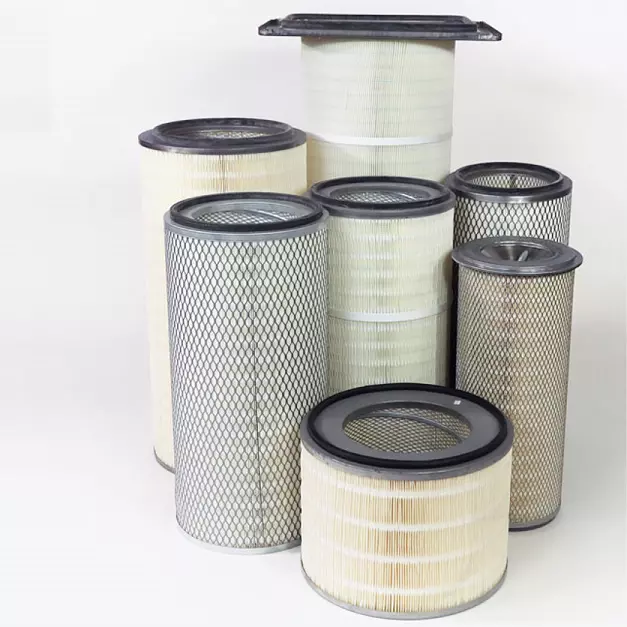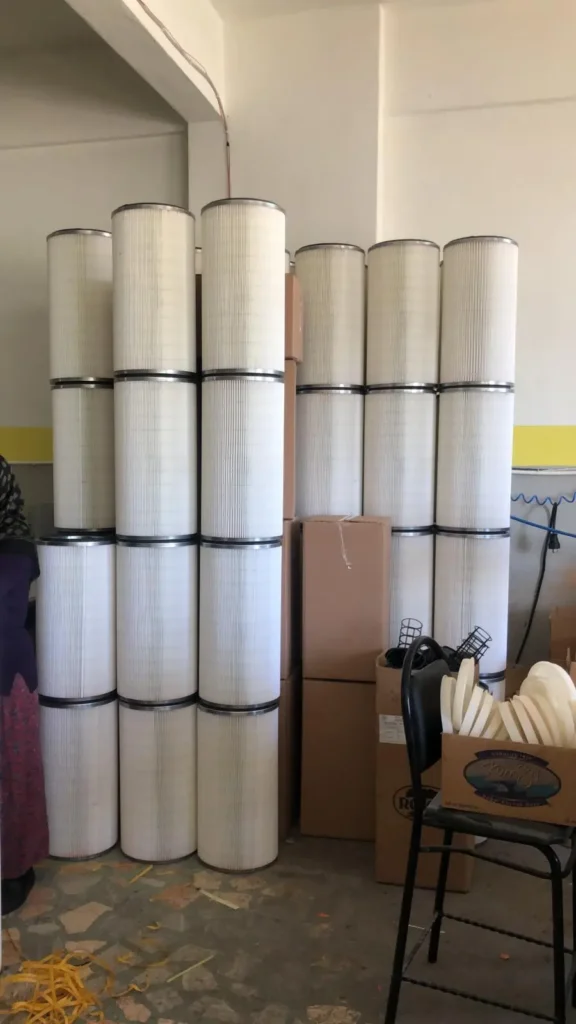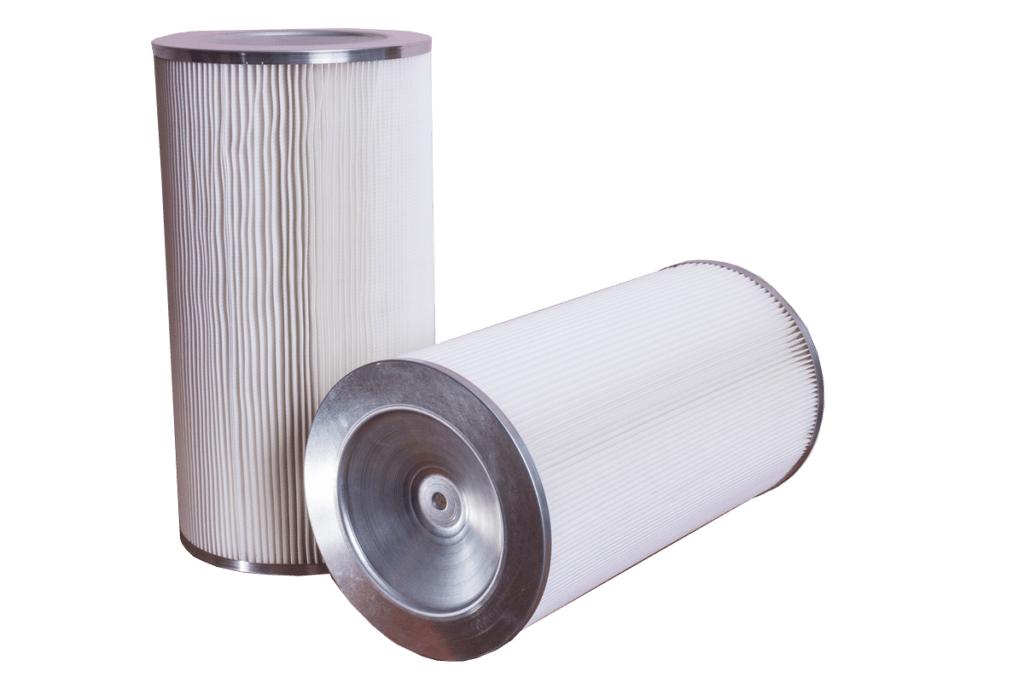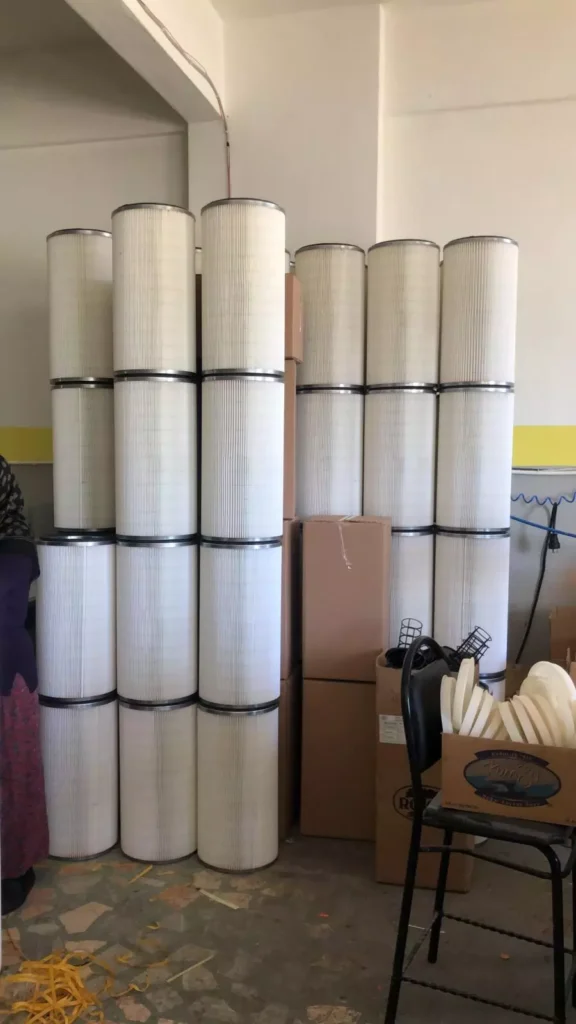
To choose the best filter for powder coating booth, you can consult us for free. We manufacture powder coating filters for any powder spray booth.
Powder coating is increasingly accepted as the preferred finishing process for many applications. Increasingly stringent environmental regulations, rising costs in all areas, and demands by consumers for better quality and more durable products are among the challenges facing today’s finishers. Powder coatings provide a solution to these challenges and others. Powder coating is the technique of applying dry paint to the component.
The powdered paint is normally applied by using a powder feed system and gun to electrostatically charge and spray the powder onto the part.
For some applications, the part being coated is dipped into a fluidized bed of powder. The coated part is then heated in an oven, or via infrared panels, to melt and cure the paint. During the curing process, a chemical cross-linking reaction is triggered and it is this chemical reaction that gives the powder coatings many of their desirable properties.
Best Filter for Powder Coating Booth Characteristics
The best filter for a powder coating booth will depend on the specific application and the type of powder being used. However, some general characteristics of good filters for powder coating booths include:
- High efficiency: The filter should be able to remove at least 98% of the powder particles from the air.
- Long life: The filter should be able to last for at least 6 months before it needs to be replaced.
- Easy to clean: The filter should be easy to clean and replace.
- Cost-effective: The filter should be cost-effective to purchase and operate.
Here are some of the best filters for powder coating booths:
1. Bag filters
Bag filters are a popular type of filter for powder coating booths because they are efficient, durable, and easy to clean. Bag filters consist of a series of bags made of a filter material, such as cloth or paper. The powder particles are trapped in the bags as the air passes through them. Bag filters are typically used to capture larger powder particles, while other types of filters are used to capture smaller particles.
2. Cartridge filters
Cartridge filters are another popular type of filter for powder coating booths. They are similar to bag filters, but they use cartridges instead of bags. Cartridges are typically made of a pleated filter material, which provides more surface area for filtering. This makes cartridge filters more efficient than bag filters at capturing smaller powder particles.
3. HEPA filters HEPA filters are the most efficient type of filter for powder coating booths. They are able to remove at least 99.97% of particles from the air, including very small particles. HEPA filters are typically used to capture the smallest powder particles, such as those that are released when powders are cured in an oven.
4. Activated carbon filters
Activated carbon filters are used to remove odors and fumes from powder coating booths. Activated carbon is a porous material that has a large surface area. This allows it to trap odor molecules and fumes as the air passes through it. Activated carbon filters are typically used in conjunction with other types of filters, such as bag filters or cartridge filters.
The three key factors to consider when selling replacement filters are type, dimension and efficiency.
Filter Type

Filter type provides the basic design parameter to ensure a proper cross-reference for a replacement product of a similar type and design. The color, texture, and other key visual features may have importance. The filter type is usually determined by the frame system that holds the filters.
Filter dimension is also a factor controlled by the frame system. The limitations of the actual filter frame will determine the overall filter dimension and the size options that may fit within an existing framework. Filter dimensions are most commonly provided in nominal dimensions, not exact dimensions.
Paper Filters for Powder Coating
Paper filters are a type of air filter that is commonly used in powder coating booths. They are made of a series of pleated paper sheets that are bonded together. The pleats increase the surface area of the filter, which allows it to capture more powder particles. Advantages of using paper filters for powder coating:
- High efficiency: Paper filters are able to capture at least 95% of the powder particles from the air.
- Long life: Paper filters can last for up to 6 months before they need to be replaced.
- Easy to clean: Paper filters are easy to clean and replace.
Disadvantages of using paper filters for powder coating:
- Not as efficient as other types of filters: Paper filters are not as efficient as other types of filters, such as HEPA filters.
- Can be damaged by moisture: Paper filters can be damaged by moisture, so they should not be used in humid environments.
- Can be expensive: Paper filters can be more expensive than other types of filters.
Overall, paper filters are a good option for powder coating booths that are not in high use. They are efficient, long-lasting, and easy to clean. However, if you need a more efficient filter, you should consider using a HEPA filter.
Here are some additional things to keep in mind when using paper filters for powder coating:
- Make sure that the filter is the correct size for your booth.
- Replace the filter regularly, or as needed.
- Clean the filter regularly to remove any accumulated powder.
- Dispose of used filters properly.
Polyester Filters for Powder Coating
Polyester filters are a type of air filter that is commonly used in powder coating booths. They are made of a series of pleated polyester fibers that are bonded together. The pleats increase the surface area of the filter, which allows it to capture more powder particles. Polyester filters are more efficient than paper filters and can last for up to 12 months before they need to be replaced. They are also more resistant to moisture than paper filters.
Advantages of using polyester filters for powder coating:
- High efficiency: Polyester filters are able to capture at least 99% of the powder particles from the air.
- Long life: Polyester filters can last for up to 12 months before they need to be replaced.
- Resistant to moisture: Polyester filters are resistant to moisture, so they can be used in humid environments.
- Durable: Polyester filters are more durable than paper filters and can withstand high temperatures.
- Cost-effective: Polyester filters are more cost-effective than other types of filters, such as HEPA filters.
Disadvantages of using polyester filters for powder coating:
- Not as efficient as HEPA filters: Polyester filters are not as efficient as HEPA filters at capturing very small particles.
- Can be difficult to clean: Polyester filters can be difficult to clean, so they should be replaced regularly.
- Can be damaged by chemicals: Polyester filters can be damaged by some chemicals, so they should not be used in areas where there are a lot of chemicals.
Overall, polyester filters are a good option for powder coating booths that are in high use. They are efficient, long-lasting, and resistant to moisture. However, if you need a filter that can capture very small particles, you should consider using a HEPA filter.
Here are some additional things to keep in mind when using polyester filters for powder coating:
- Make sure that the filter is the correct size for your booth.
- Replace the filter regularly, or as needed.
- Clean the filter regularly to remove any accumulated powder.
- Dispose of used filters properly.
Teflon Coated Powder Coating Filters
Teflon is a fluoropolymer, which is a type of plastic that is known for its non-stick properties. This makes it an ideal material for coating powder coating filters, as it helps to prevent the powder from sticking to the filter and clogging it.
Teflon-coated powder coating filters are a good option for applications where there is a lot of powder being used, or where the powder is sticky or difficult to remove. They are also a good option for use in humid environments, as Teflon is resistant to moisture.
Here are some of the benefits of using Teflon-coated powder coating filters:
- Non-stick: The Teflon coating helps to prevent the powder from sticking to the filter, which makes it easier to clean and replace.
- Durable: Teflon is a durable material that can withstand high temperatures and harsh chemicals.
- Easy to clean: Teflon-coated filters can be easily cleaned with a mild detergent and water.
- Resistant to moisture: Teflon is resistant to moisture, so it can be used in humid environments.
Here are some of the drawbacks of using Teflon-coated powder coating filters:
- More expensive: Teflon-coated filters are more expensive than uncoated filters.
- Not as efficient: Teflon-coated filters are not as efficient at capturing small particles as uncoated filters.
- Can be damaged by high temperatures: Teflon can be damaged by high temperatures, so it should not be used in applications where the filter will be exposed to temperatures above 500°F.
Overall, Teflon-coated powder coating filters are a good option for applications where there is a lot of powder being used, or where the powder is sticky or difficult to remove. They are also a good option for use in humid environments. However, they are more expensive than uncoated filters and are not as efficient at capturing small particles.
Best Filter for Powder Coating Booth Efficiency
Filters are designed to trap contaminants in the air from
entering or exiting the paint booth, protecting your paint job,
the operator, and the environment. Thus, the efficiency of each filter in the booth is critical. The required efficiency rating of a filter depends on the type of filter and how it is used.

Exhaust and intake are the most commonly discussed and
used filters in a paint booth, however, there are several other locations in a paint booth that uses filtration. It is important to understand all the filtration locations in a paint booth and ensure that they are replaced on a routine basis to ensure the safety and performance of the booth. In addition to filters for liquid booths, Global Finishing Solutions (GFS) also supply replacement filters for powder booths, ovens, and all our finishing equipment. In this guide, we will cover recommendations for replacing filters in all these products.
Best Filter for Powder Coating Booth Specifications

There are two basic types of powder coating systems: spray-to waste and reclaim. Spray-to-waste powder systems are designed to treat overspray in a manner similar to liquid spray operations. No effort is made to reuse the coating material once sprayed. Spray-to-waste powder systems may
use a multi-stage filter system, similar to those used with liquid spray coating for aerospace, or cylindrical cartridge filters.
Reclaim systems are specifically engineered to allow the collection of sprayed powder coating material for reuse. In these systems, either a single coating is sprayed on all parts, or separate filter modules are dedicated to specific coating materials to prevent cross-contamination of the coating material in batch coating operations. Both allow for the reclamation of the coating material for reuse. Reclaim systems are only offered with cylindrical cartridge filters.
Powder for Surface Coatings
The concept of finishing metallic surfaces by applying dry powders which, when fused, form continuous and integrated coatings, has developed steadily since its practical inception in the mid1950s. Initiallythermoplastic resins were employed, but within the last three decades, thermosetting powders have been developed which open up a much wider field of use.
The increasing use of thermosetting powders has been necessary because of the need to reduce air and water pollution coupled with the fact that with today’s rising costs of basic raw materials and labor, powder coating is often a viable commercial consideration when compared to conventional industrial liquid paints. Some of the more obvious advantages of using thermosetting powders are:
Ready for use
Powders are immediately ready for use. They do not have to be mixed with any other ingredients such as solvents or catalysts. This saves on shop floor time and also eliminates a variable that it is vital to control with liquid paints to obtain satisfactory film properties.
Reduction in the fire risk as no solvent required
As no solvent is required with powders, there is a reduction in fire risk which gives cost savings on statutory safety features in plants, reduces insurance premiums and savings can be made on manpower time.
Powders, because they are solvent-free, are not subject to the Highly Flammable Liquids and LiquefiedPetroleum Regulations (1972), or similar Regulations and Orders containing requirements in respect of flammable liquids. For information on possible dust and explosion hazards arising from powder usage, see section 6 ‘Safety Considerations’.
No costly wastage of solvent: environmental cleanliness
There is no costly wastage of solvents which, at application viscosity, constitutes up to 70% of conventional liquid paints. These solvents, which volatilize during application and stoving are usually not recoverable and legislation introduced in various parts of the world has prohibited their discharge to the atmosphere in some cases, therefore, after-burners have had to be installed to eliminate solvents with an attendant increase in costs.
This legislation covering atmospheric pollution and effluent is extremely important. An example is the German ‘TA-Luft’ Regulation
This regulates thecontent of gaseous or vaporous material in exhaust streams. These materials are divided into 3 classes. Each class has a specified maximum massconcentration in the exhaust air which may not be exceeded at or above a specified total MASS flow.

No effluent disposal problems
With liquid paint systems, water wash spray booths are commonly employed. The overspray is usually emulsified in the water, which in some cases is put directly into the drain or in other cases, allowed to settle out in sludge tanks. Powders do not give rise to these problems and extra costs.
No air pollution
– Overspray powder is recoverable and no powder needs to escape into the atmosphere.
Reduced health hazards to operators
– There is a reduction in health hazards to operators. As powder does not contain solvent there is a marked reduction innose, mouth, and throat irritation as is sometimesnoticeable particularly during hot weather in liquid paint shops. Any liquid paint which comes into contactwith an operator’s skin needs to be washed off with solvent, and then removed by emulsifying with soap in hot water. In difficult cases, special industrial handcleaners have to be employed.
These remove essentialoils from the skin and in some cases can cause skinirritation. In general, the powder does not cause skin irritation though in rare cases individuals may react tocertain types of powder.
The powder can be removed from the skin easily by washing with warm water. Concern in recent years about the possible mutagenic effects of TGIC, one of the materials commonly used in powder coatings, has been alleviated after the development of TGIC-free products provided an alternative option.
Considerable improvements have also been made in reducing the heavy metal content of powders, in the particular lead. Lead-free products are now achievable for the vast majority of shades.
Processing time reduced
– Powder processing times are generally shorter than those used for wet stoving paints since, as there is no solvent, no flash-off period is required; the powder-coated articles can pass directlyinto the oven. This gives substantial savings in spaceand time.
Economy in reduced energy requirements
– There is cost saving during stoving because no energy is required to evaporate the solvent and evacuate it from the oven.
Superior film properties
– With solvent-based systems, the solvent balance must be carefully adjusted to the polymeric type, application and curing conditions, as many film defects can be traced directly to incorrect solvent balance. With powders, no such condition exists and in general superior film properties such as adhesion and corrosion resistance are obtained in powders compared to polymers deposited from liquid systems
Damaged parts are easily rectified
– Damaged or poorly coated areas can be easily rectified before baking by blowing off the powder and re-coating.
Air requirements reduced: cost savings
Air extraction in a powder spray booth is very much less than for solvent-based paints and this leads to economies in ventilation and consequential heating of work areas. As less warm air has to be replaced in workshops, less dust is attracted and there is less air draught for the operators to contend with.
95% powder utilization
– Material loss can be kept to less than 5% by powder overspray recovery. The powder recovered can be blended with virgin powder to provide up to 95% utilization.
Controlled film thickness
– A controlled more uniform and, if required, a higher film thickness can be obtained with powders than with conventional paint systems in one application. Improvements in the appearance of thin films have also made this a viable option for certain applications.
Wide range of coatings is available
– A broad variety of decorative and functional coatings are achievable using powder. These range from matt to high gloss, smooth to a textured finish, and include metallic and other specialty effects. Choice of polymer type can optimize properties such as corrosion resistance and exterior durability.
Minimal operator training required for application
– Operators require much less training to apply powders than solvent-based systems.
Surface pretreatment
– As with most coated metallic surfaces, preparation and pretreatment are important to maximize corrosion and environmental resistance.
Powder cleaner to use
– Applying powder is much cleaner than applying wet paint. A spray booth can be cleaned down by the use of a rubber squeegee whilst the normal air extraction in the booth is operating. Brushes and an air hose should not be used for this purpose. Any spillages of powder outside the booth should be removed with an industrial vacuum cleaner which is fitted with an air-driven or dust-tight motor.
Powder application plant is less costly
– Powder application plant, either manual or automatic, is extremely simple to operate and less costly than a two-coat liquid electro-deposition system.
Lower cost of packaging for coated articles
– A much higher order of physical and chemical resistance is obtained with thermosetting powder polymers than with their liquid counterparts. This leads to a lowering of the cost of protecting the work during transportation to the user.
Non-metallic surfaces can be coated
– Surfaces such as glass and certain thermosetting moldings which can withstand the stoving temperatures involved can be powder coated. The scope of materials that can be used is ever-increasing as advancements in lower bake technologies are made.
Less storage space is required for the powder
– Less storage space is required for powder compared to paint which means cost savings on factory floor space. There are, however, certain disadvantages to using thermosetting powders and these include:
Thin films difficult to obtain
– Thin films (µ25microns) are more difficult to obtain with powders than with wet paint systems. However, the overall economics of applying a somewhat thicker coating of powder could still prove favorable.
Colour change slower
– Colour change is more rapid in liquid paints than with powders. However, improvements in application equipment and cleaning techniques have reduced this time considerably in recent years.
Powders cannot be mixed
– Powders cannot be mixed with one another to obtain different colors. However, this is not considered vital as most industrial coaters use paints or powders already matched to specific shades
